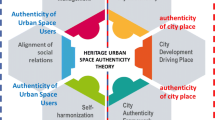Abstract
The objective of this paper is to challenge three implicit assumptions about residents’ engagement with city branding: first, that disengaged residents may not be attached to their place; second, that residents’ desire engagement with official place branding; and third, that residents perceive place branding is appropriate for their city. In-depth semi-structured interviews were held with 22 residents of Dunedin, New Zealand, to examine their place attachment, place identity, understanding of city branding and attitudes toward their city’s brand. To assist residents to articulate their feelings about Dunedin, a visual elicitation method was used to assist them to articulate their place identity and place attachment. The findings identify tensions between residents’ place identity, their understanding of city branding and attitudes toward their city’s brand, underpinned by their attachment to the city. Many residents expressed place-protective attitudes towards anticipated changes to the social fabric of their community, which they perceive to be consequences of this urban governance strategy. Local authorities may need to re-think their adoption of place branding as a ‘one-size fits all’ solution to place management and find alternatives which promote the perceived uniqueness of the city while reinforcing residents’ multiple and complex place identities.

Similar content being viewed by others
References
Anton, C.E., and C. Lawrence. 2014. Home is where the heart is: The effect of place of residence on place attachment and community participation. Journal of Environmental Psychology 40: 451–461.
Braun, E., M. Kavaratzis, and S. Zenker. 2013. My city—my brand: The role of residents in place branding. Journal of Place Management and Development 6: 18–28.
Braun, V., and V. Clarke. 2006. Using thematic analysis in psychology. Qualitative Research in Psychology 3: 77–101.
Breakwell, G. 2015. Coping with threatened identities. London: Psychology Press.
Creswell, J. 2003. Research design: Qualitative, quantitative and mixed methods approaches. Thousand Oaks: Sage Publications Inc.
Devine-Wright, P. 2009. Rethinking NIMBYism: The role of place attachment and place identity in explaining place-protective action. Journal of Community & Applied Social Psychology 19: 426–441.
Dixon, J., and K. Durrheim. 2000. Displacing place-identity: A discursive approach to locating self and other. British Journal of Social Psychology 39: 27–44.
Dunedin City Council. 2002. Monitoring Population: August 2002. Dunedin: Dunedin City Council.
Eshuis, J., and A. Edwards. 2012. Branding the city: The democratic legitimacy of a new mode of governance. Urban Studies 50: 1–17.
Fairfax Media. (2012) Top 10 worst NZ city slogans. stuff.co.nz.
Giuliani, V. 2003. Theory of attachment and place attachment. In Psychological theories for environmental issues, ed. M. Bonnes, T. Lee, and M. Bonaiuto, 137–170. Aldershot: Ashgate.
Gotham, K.F. 2007. Authentic New Orleans: Tourism, culture, and race in the big easy. New York: New York University Press.
Guest, G., A. Bunce, and L. Johnson. 2006. How many interviews are enough?: An experiment with data saturation and variability. Field Methods 18: 59–82.
Hay, R. 1998. Sense of place in the developmental context. Journal of Environmental Psychology 18: 5–29.
Hooker, J. 2007. Branding Dunedin: Passionate, active, vibrant, youthful. In Working on the edge: A portrait of business in Dunedin, ed. K. Inkson, V. Browning, and J. Kirkwood, 78–87. Dunedin: Otago University Press.
Insch, A., and M. Florek. 2008. A great place to live, work and play: Conceptualising place satisfaction in the case of a city’s residents. Journal of Place Management and Development 1: 138–149.
Insch, A., and M. Stuart. 2015. Understanding resident city brand disengagement. Journal of Place Management and Development 8: 172–186.
Kavaratzis, M. 2012. From ‘necessary evil’ to necessity: stakeholders’ involvement in place branding. Journal of Place Management and Development 5: 17–19.
Kavaratzis, M., and G.J. Ashworth. 2008. Place marketing: How did we get here and where are we going? Journal of Place Management and Development 1: 150–165.
Kavaratzis, M., and A. Kalandides. 2015. Rethinking the place brand: The interactive formation of place brands and the role of participatory place branding. Environment and Planning A 47: 1368–1382.
Kemp, E., C. Childers, and K. Williams. 2012. A tale of a musical city: Fostering self-brand connection among residents of Austin, Texas. Place Branding and Public Diplomacy 8: 147–157.
Korpela, K.M. 1989. Place identity as a product of environmental self regulation. Journal of Environmental Psychology 9: 241–256.
Lincoln, Y.S., and E.G. Guba. 1985. Naturalistic inquiry. Newbury Park: SAGE Publications.
Low, S.M., and I. Altman. 1992. Place attachment: a conceptual inquiry. In Human Behavior and Environment, ed. I. Altman, and S.M. Low, 1–12. New York: Planum.
Maher, K.H., and D. Carruthers. 2014. Urban Image Work: Official and grassroots responses to crisis in Tijuana. Urban Affairs Review 50: 244–268.
Maiello, A., and C. Pasquinelli. 2015. Destruction or construction? A (counter) branding analysis of sport mega-events in Rio de Janeiro. Cities 48: 116–124.
Mayes, R. 2008. A place in the sun: The politics of place, identity and branding. Place Branding and Public Diplomacy 4: 124–135.
Merrilees, B., D. Miller, and C. Herrington. 2009. Antecedents of residents’ city brand attitudes. Journal of Business Research 62: 362–367.
Patton, M.Q. 1990. Qualitative evaluation and research methods. London: Sage.
Proshansky, H.M., A.K. Fabian, and R. Kaminoff. 1983. Place identity: Physical world socialization of the self. Journal of Environmental Psychology 3: 57–83.
Ramkissoon, H., L. David, G. Smith, et al. 2013. Relationships between place attachment, place satisfaction and pro-environmental behaviour in an Australian national park. Journal of Sustainable Tourism 21: 434–457.
Scannell, L., and R. Gifford. 2010. Defining place attachment: A tripartite organizing framework. Journal of Environmental Psychology 30: 1–10.
Statistics New Zealand. 2006. 2006 Census QuickStats about a place: Dunedin City. http://www.stats.govt.nz/Census/2006CensusHomePage/QuickStats/AboutAPlace/SnapShot.aspx?tab=Agesex&id=2000071.
Statistics New Zealand. 2013. 2013 Census QuickStats about a place: Dunedin City. http://www.stats.govt.nz/Census/2013-census/profile-and-summary-reports/quickstats-about-a-place.aspx?request_value=15022&parent_id=14973&tabname=#.
Stedman, R.C. 2002. Toward a social psychology of place: Predicting behavior from place-based cognitions, attitude, and identity. Environment and Behavior 34: 561–581.
Stedman, R.C., T. Beckley, S. Wallace, et al. 2004. A picture and 1000 words: Using resident-employed photography to understand attachment to high amenity places. Journal of Leisure Research 36: 580–606.
Strauss, A., and J. Corbin. 1990. Basics of qualitative research: Grounded theory procedures and techniques. Newbury Park: SAGE Publications Inc.
Twigger-Ross, C.L., and D. Uzzell. 1996. Place and identity processes. Journal of Environmental Psychology 16: 205–220.
Uzzell, D., E. Pol, and D. Badenas. 2002. Place identification, social cohesion, and environmental sustainability. Environment and Behavior 34: 26–53.
Zenker, S., and S.C. Beckman. 2013. My place is not your place—different place brand knowledge by different target groups. Journal of Place Management and Development 6: 6–17.
Zenker, S., and S. Petersen. 2014. An integrative theoretical model for improving resident-city identification. Environment and Planning A 46: 715–729.
Zenker, S., and A. Seigis. 2012. Respect and the city: The mediating role of respect in citizen participation. Journal of Place Management and Development 5: 20–34.
Author information
Authors and Affiliations
Corresponding author
Rights and permissions
About this article
Cite this article
Insch, A., Walters, T. Challenging assumptions about residents’ engagement with place branding. Place Brand Public Dipl 14, 152–162 (2018). https://doi.org/10.1057/s41254-017-0067-5
Revised:
Published:
Issue Date:
DOI: https://doi.org/10.1057/s41254-017-0067-5




